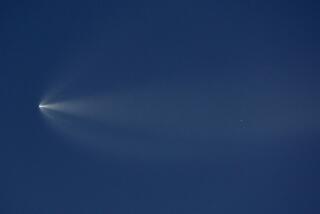SpaceX launch brings Elon Musk’s broadband-internet satellite plan closer to reality

SpaceX is one step closer to providing low-cost broadband internet access after launching the first two demonstration satellites for its planned satellite constellation Thursday morning.
The two demonstration satellites, known as Microsat-2a and Microsat-2b, were the secondary payload on Thursday’s Falcon 9 mission, which launched at 6:17 a.m. from Vandenberg Air Force Base in California.
The primary mission of the launch was to take a radar imaging satellite into low-Earth orbit for a Spanish operator. That satellite deployed about 11 minutes after liftoff.
The launch used a previously used Falcon 9 first-stage booster. As planned, the Hawthorne company — which is led by Elon Musk and whose full name is Space Exploration Technologies Corp. — did not try to recover that booster again Thursday.
SpaceX intends to create a constellation of satellites known as Starlink that would provide broadband internet access and eventually consist of thousands of satellites.
The two demonstration satellites launched Thursday are intended to test the spacecrafts’ design, structure and subsystems. SpaceX also plans to test the satellites’ communication paths using five stationary ground-based test stations and three mobile test vans, according to past filings with the Federal Communications Commission.
Test stations will be located in Hawthorne and Fremont in California; McGregor and Brownsville, Texas; and Redmond, Wash., where SpaceX has an office dedicated to satellite development.
The demo satellites’ deployment was not shown on SpaceX’s webcast of the launch, but about an hour and a half afterward, Musk tweeted that they had deployed and were communicating with ground stations on Earth.
A filing with the FCC dated Feb. 1 called the satellites Microsat-2a and Microsat-2b, but Musk referred to them as Tintin A and B, an apparent reference to the young reporter/adventurer character in the famed comics by Hergé.
The two satellites will try to deliver the message “Hello, world” when they pass near Los Angeles on Friday morning, Musk said.
SpaceX said during the webcast that even if the test satellites are successful, there still will be work ahead to prepare for future deployment of satellites for the constellation.
Thursday’s launch was originally scheduled for last Saturday. It was delayed several times to give SpaceX more time for “prelaunch systems checks,” including final checkouts of an upgraded fairing — the clamshell-like covering that protects satellites at the top of the rocket.
Twitter: @smasunaga







